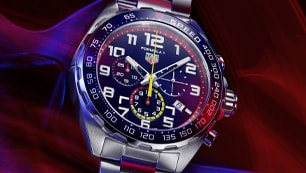



Utmost Precision
The dial is the truly aesthetic of the watch. It has to convey information clearly while looking attractive. Making a dial is incredibly complicated, necessitating numerous production techniques. Dials are made from brass. However, before the metal can be used, it has to be heated to 750°C in order to make it soft. A continuous length of brass is fed into a stamping press and subject to immense pressure, sometimes as much as 400 tonnes. Feet are fitted to the underside of the dial, allowing it to be subsequently fixed to the movement. A pressing technique, using colossal force, is used to impart various patterns to the dial surface, enhancing its visual appearance. A series of holes are made in the dial surface, which serve a variety of uses. For example, a central hole allows the canon pinion to peep through the dial and connect with the hour and minute hands.

GALVANOPLASTY
TAG Heuer produce watches incorporating a myriad of dial shades. The colours are applied using electroplating, a process which also protects the dial surface from ageing. While the main colour of the dial is achieved through electroplating, there is sometimes a need to apply other coloured details, such as TAG Heuer’s emblem.

MARKINGS AND SIGNATURES
Special paints are applied to the dial surface using a pad printing machine. A watchmaker is needed to ensure that just the right amount of paint is applied to the dial membrane. The paint is quick drying, preventing any applied text or motif from smudging. The cutting-edge machines employed by TAG Heuer can apply up to five different colours to the dial surface in quick succession.

READABILITY
Indexes, representing the hours, are applied to the dial surface by hand, providing depth to the display. Pins on the underside of the indexes pass through the holes drilled in the dial surface. A laser is used to join the indexes to the dial. A key attribute of any TAG Heuer watch is legibility even in dim light conditions. Super-LumiNova® is a pigment which exhibits a glow in darkness. This material is applied to the indexes and hands using a syringe. On completion, the dial is checked beneath ultraviolet light in order to ensure legibility even in total darkness. Once the dial is complete, it is placed in a sealed container and forwarded to the Assembly Department.







